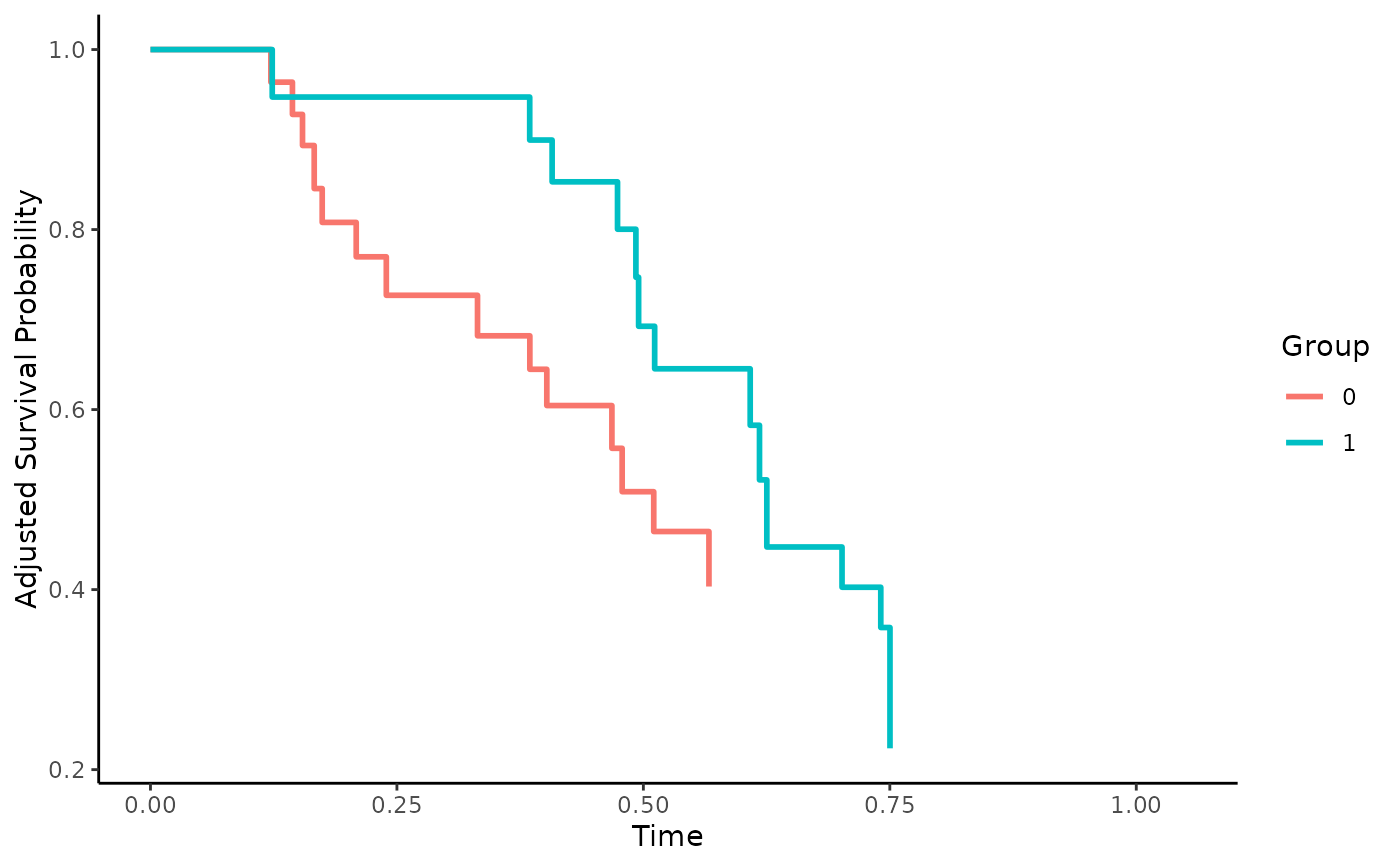
Adjusted Survival Curves for Categorical Confounders using the Method by Gregory (1988) and Nieto & Coresh (1996)
surv_strat_nieto.RdThis page explains the details of estimating confounder-adjusted survival curves using a weighted average of stratified Kaplan-Meier estimates using the method described in Gregory (1988) and Nieto & Coresh (1996) (method="strat_gregory_nieto" in the adjustedsurv function). All regular arguments of the adjustedsurv function can be used. Additionally, the adjust_vars argument has to be specified in the adjustedsurv call. Further arguments specific to this method are listed below.
Details
Type of Adjustment: The survival curves are adjusted by taking a weighted average of stratified Kaplan-Meier estimates. This only works for categorical confounders. See below for more information.
Doubly-Robust: Estimates are not Doubly-Robust.
Categorical groups: Any number of levels in
variableare allowed. Must be a factor variable.Approximate Variance: Calculations to approximate the variance and confidence intervals are available. The estimator for the variance can be found in the appendix of Nieto & Coresh (1996).
Allowed Time Values: Allows both continuous and integer time.
Bounded Estimates: Estimates are guaranteed to be bounded in the 0 to 1 probability range.
Monotone Function: Estimates are guaranteed to be monotone.
Dependencies: This method has no additional dependencies.
This is one of the older adjustment methods described in the literature. It only works for categorical confounders. If adjustments for continuous confounders are desired, the user needs to explicitly categorize the continuous confounders. It is recommended to use one of the other methods implemented in this package in that case. The method works exactly as described in Gregory (1988). Similarly to the method described in strat_cupples, Kaplan-Meier estimates are calculated for each strata and a weighted average is taken. The only difference is a slightly different weighting scheme. Weights are calculated using the pooled sample (data). In contrast to other stratification based methods, external reference data is not allowed. A more detailed description can be found in the original article.
If a character vector is supplied in the adjust_vars argument, the Kaplan-Meier estimates are created for each combination of all supplied variables. If the sample size is small and/or there are many levels in these variables, the estimates can become unstable or undefined. Because it is a weighted average of Kaplan-Meier curves, estimates for this method are only defined for points in time with a valid Kaplan-Meier estimate in all strata. For example, if the Kaplan-Meier curve of the strata "Treatment + male" only extends to t = 100, it will be impossible to estimate the adjusted survival curve for t > 100 using this method.
Nieto & Coresh (1996) proposed a very similar method. The only major difference is that Nieto & Coresh (1996) used the control group as reference population, which results in a different causal estimand. Using the method by Nieto & Coresh (1996) with the full data as reference population as described in Gregory (1988) produces exactly the same results. Nieto & Coresh (1996) seemed to be unaware of the method by Gregory (1988), as they did not mention it in their article. In contrast to Gregory (1988) they however also proposed an approximate estimator of the variance, which is implemented here. Their formulation of this estimator also allows the use of time-dependent covariates and left-truncated data. This is however not implemented here.
References
W. M. Gregory (1988). "Adjusting Survival Curves for Imbalances in Prognostic Factors". In: British Journal of Cancer 58, pp. 202-204
F. Javier Nieto and Josef Coresh (1996). "Adjusting Survival Curves for Confounders: A Review and a New Method". In: American Journal of Epidemiology 143.10, pp. 1059-1068
Examples
library(adjustedCurves)
library(survival)
set.seed(42)
# simulate some data as example
sim_dat <- sim_confounded_surv(n=50, max_t=1.2)
sim_dat$group <- as.factor(sim_dat$group)
# adjust survival curves for some categorical confounders
adjsurv <- adjustedsurv(data=sim_dat,
variable="group",
ev_time="time",
event="event",
method="strat_nieto",
adjust_vars=c("x1", "x3"),
conf_int=FALSE)
# plot the curves
plot(adjsurv)
#> Warning: Removed 7 rows containing missing values or values outside the scale range
#> (`geom_step()`).
